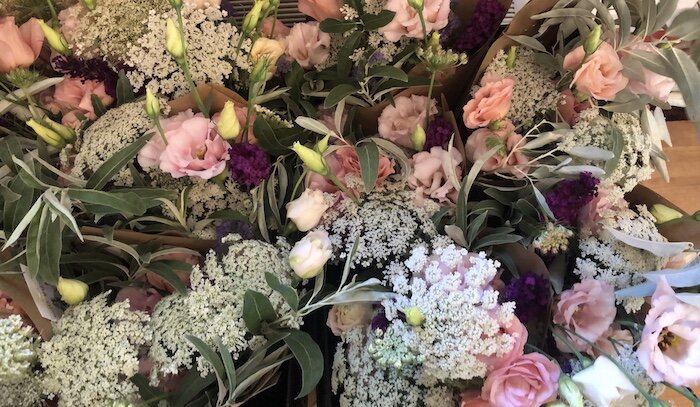Week One Flower Bouquet CSA: The bride of amazement
This is your first week in flowers. When I gathered all the buckets together and saw the silver-white, blush and lavender I felt like I was heading to a wedding! So the title of this bouquet is The Bride of Amazement. It is inspired by a line from a Mary Oliver poem When Death Comes.
“When it’s over, I want to say: all my life I was a bride married to amazement. I was the bridegroom, taking the world into my arms.”
I often hear people lamenting that they wish they could get married so they can have a "reason" for me to create beautiful floral designs for them. While I delight in making amazing wedding flower arrangements, I resent our culture that obliges marriage as the ultimate moment for a woman to celebrate herself. I believe that flower rituals should be sown into so many more of our life moments. Let today’s bouquet be a moment for you to celebrate loving yourself, being married not to another being, but to the amazement you find in the world.
Joan, a CSA member is an artist and bride of amazement
Jason, a creative and loyal bouquet customer is wedded to amazement
The elements in this week's design include:
Blush and apricot lisianthus: this luscious beauty is in the gentian family and the genus Eustoma grows in prairies in the warmer parts of the world. These seeds were sown in January, by a commercial grower in VT who I sometimes buy the harder-to-grow flowers from in plug trays of hundreds of plants. I planted them the first week of April and they are in full shine now.
The beauty of lisianthus makes me giddy with delight! This flower shall not be reserved only for wedding days
Queen Anne's Lace: This delicate, lacy flower is found in meadows and is in the carrot family. The wide landing zone of tiny flowers making up the bloom attracts many beneficial insects. If you find ladybugs, just take them outside!
Butterfly bush: I love the deep purple spikes and honey-like fragrance that emanates from this hardy bush. As its name suggests it attracts butterflies and pollinators of all kinds.
Bluebeard: Another hardy perennial shrub that thrives in full sun. I love the fragrant, silvery foliage that gives it away to being a mint family relative.
Russian olive: I used to kill these trees, now I love them! These trees are highly exotic in our desert waterways, so I feel really good about randomly harvesting some branches from around Flagstaff. Birds love the olives and are somewhat responsible for their spread, combined with land management practices that dam rivers and put our natives at a disadvantage.
Hand-tied bouquets ready to be delivered to our CSA members.




